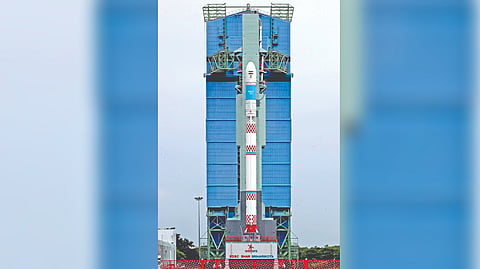

CHENNAI: The Second Developmental Flight of the Small Satellite Launch Vehicle (SSLV-D2) carrying the Earth Observation Satellite (EOS-07) and two co-passenger satellites will take place on February 10 from the spaceport of Sriharikota.
Indian Space Research Organisation (ISRO) sources on Monday said the SSLV-D2 will lift off from the First Launch Pad at 09 18 hrs on Friday.
While EOS-07 will be the primary satellite, the two co-passengers satellites are Janus-01 from Antaris US Firm and the other is from a domestic player.
SSLV-D2 will launch a total payload mass of about 334 kg, including EOS-07 satellite and the two co-passenger satellites.
The satellite will be injected into a Circular Low Earth Orbit at an altitude of 450 km with an inclination of 37.2 Deg to the equator.
The SSLV is designed to be affordable and amenable to industry production and will function as a launch-on-demand platform for Mini, Micro or Nano satellites. It is a three-stage vehicle with all solid propulsion stages and liquid propulsion-based Velocity Trimming Module (VTM) as the terminal stage.
The launcher also targets many novel features, including low turn-around time, flexibility in accommodating multiple satellites, launch-on-demand, minimal launch infrastructure requirements, etc.
The first developmental flight of SSLV-D1/E0S-02 that took place on August 7 last year was unsuccessful.
The objective of the mission was to inject EOS-02 satellite into a circular orbit of 356.2 km with an inclination of 37.21 Deg. It also carried Azaadisat, a student satellite.
However, the spacecraft were injected into a highly elliptical unstable orbit due to a shortfall in velocity, leading to their decay and deorbiting immediately, in spite of the normal performance of all solid propulsion stages.
The orbit achieved was 360.56 km x 75.66 km with an inclination of 36.56 deg. Initial investigations with the flight data indicated that the lift-off of SSLV D1 was normal along with normal performance of all solid propulsion stages.
However, the mission could not be achieved due to an anomaly during the second stage (SS2) separation, which triggered a mission salvage mode (which is a procedure adopted to attempt minimum stabilised orbital conditions for the Spacecraft in case of an anomaly in the vehicle system).
The Failure Analysis Committee (FAC) of ISRO, which went into the causes of the failure, found that vibration distance for a short duration led to the failure.
In its report, the FAC said, “subsequent detailed analysis of the flight events and observations ranging from countdown, lift-off, propulsion performance, stage separations and satellite injection revealed that there was a vibration disturbance for a short duration on the Equipment Bay (EB) deck during the SS2 separation that affected the Inertial Navigation System (INS), resulting in declaring the sensors faulty by the logic in Fault Detection & Isolation (FDI) software
Considering the clear identification of the cause of the flight anomaly and suggested corrective actions, the SSLV-D2 is being executed complying to the recommendations, its satisfactory implementation, review and approval by the authorised committees.
Visit news.dtnext.in to explore our interactive epaper!
Download the DT Next app for more exciting features!
Click here for iOS
Click here for Android